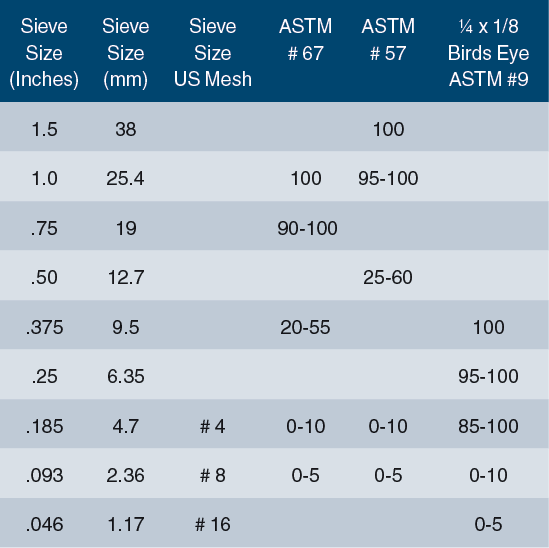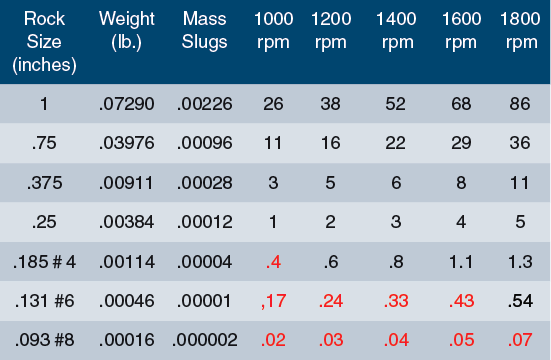All Over The World There Are Signs That Sand Shortages Will Be a Reality. Is It Time To Get Serious About Manufactured Sand?
By John Googins
This is the second in a three-part series on manufactured sand. This article focuses on crushers used to manufacture concrete sand from rock. – Ed.
One of the most common problems with aggregate wash plants is that depending upon the source of material we end up with some of the feed being too small for part of the rock gradation and too large for part of the sand gradation.
The product size is 1/4- x 1/8-in. and has a lot of different names in the industry, such as pea rock, birds eye, buck shot, squeege and ASTM # 9. The amount can very as a percentage of the feed between 5% to 20%. This material has about 20% moisture and does not dewater easily. The market value is 50% of either the concrete rock or concrete sand. It is often used as pipeline bedding or buried electrical wire backfill.
If the production rate of the 1/4- x 1/8-in. is excessive, you can reduce the amount produced by changing the concrete rock specification from ASTM #67 to ASTM #57. Both gradations are similar, but the ASTM #57 has 10% to 15% more plus ½-in. rock, which allows a larger amount of 1/4- x 1/8-in. material to be added to the rock gradation without changing the amount passing the #4 sieve.

The other way of reducing the amount of 1/4- x 1/8-in. is to crush it to a gradation of 90% passing the #8 sieve. At this point it can be classified by reducing the minus 200 mesh with the existing sand processing equipment. Since the birds eye material is almost like a fine sand it retains water after it is washed. The wear cost of crushing wet material increases the wear cost by 5% to 10% for each 1% of moisture in the rock. This material will have at the least 5% moisture so the wear cost will increase by 25% to 50%.
One of the ways to decrease the moisture in the sand is to feed the wet birds eye to a high frequency dewatering screen mounted at a negative five-degree incline. That will cause the material to stack up on top of each other forming a cake of material and the water will tend to be separated out of the bottom.
The deck size would be about #16 mesh so that only the water would pass through the screen deck. The feed material is .25 x .125 so only the water would fall through the deck. This is not a perfect solution because the material will still have about 1% to 2% moisture but should be dry enough to crush without too many negative effects.
The best solution of how to process the birds eye is to remove it from the wash plant feed before you wash it. Since the wash plant feed will be between 1.5- to 1-in. x 0 you could split the feed into two sizes 1.5 x .375 and .375 x 0.
The 1.5 x .375 product would go to the wash plant. The .375 x 0 would go to a high frequency double deck screen with 1/4-in. on the top deck and .125-in. on the bottom deck. We would size the screen to pass the .125-in. x 0 in the 3/8 x 0 feed to pass the bottom deck and be added to the wash plant feed.
The 3/8- x ¼-in. retained on the top deck would also go to the wash plant. This leaves birds eye (1/4- x 1/8-in.), which should be relatively dry and easier to crush. You either crush material to sand or add some to the wash plant if you some need for a small amount washed birds eye material.
Open Circuit Closed Circuit
When crushing to produce sand the crusher feed will most often be in closed circuit with the crusher feed consisting of 25% to 35% new feed and recirculating load 65% to 75%. The finished product will be 90% passing #8 so the crusher feed will have a large percentage of #8 x #4 size material. It is important with whatever crusher you choose that any tests you do are like what you will have in the flow diagram of your plant equipment.
Cone Crusher
For the cone crusher to manufacture sand the feed hopper needs to be larger in diameter and higher in height. The diameter is 4 ft. and the height equal to or greater than the crusher head diameter.
To keep the feed with fines homogenized for a full 360 degrees of the crusher chamber, a rotor feeder with overflow chute is recommended. The crusher closed side setting will be about ¾-in. and most of the feed with recirculating load will be smaller than the closed-side setting. This requires the crusher to be fully choke fed with a four load above the top of the head to help stop the head spin; and be a large enough setting so the tramp relief system is not overloaded. Some guidelines:
- Power required 2 hp/tph of feed and product.
- Amount of product 90% passing #8 sieve 35% to 45%.
Vertical Shaft Impact Crusher (VSI)
A Vertical Shaft Impact Crusher (VSI) can be configured in two ways when used to make sand-rotor and rock box, or rotor and anvil.
Keep in mind that the percent of product in the crusher discharge will be higher in open circuit than in closed circuit. The velocity of the rock is increased with increased rpm. The reduction of the rock is performed by applying Kinetic Energy to the rock.
KE =.5 x M x V**2. So as the rock gets smaller it becomes more difficult to reduce.
When the Kinetic Energy falls below .5-ft.-lb. not much crushing or size reduction will take place.

Throughput production is about .5 tph/connected hp.
Amount of product in the crusher discharge is 25% to 35% using rotor and anvil configuration.
Since the rotor and anvil combination will produce a larger percent of sand but a higher wear cost it is best look at your wear cost at tons of product rather than wear cost per ton of throughput.
When testing in the laboratory it is important for the feed material to be the same as you will experience in the field. When tested in open circuit the gradation will have a higher percentage of product in the crusher product say 30% to 40% minus #8.
When tested with the recirculating load the feed will be smaller with 30% to 40% new feed and 60% to 70% recirculating load. The percent product in the crusher discharge can fall to as low as 15% to 20%.
Rod Mills
There are two different rod mill configurations available.
Overflow mill – At the feed end the opening is 3 ft. in diameter and the discharge end is 4 ft. in diameter. The problem with this type of mill is it designed to maximize the production of minus 100 and 200 mesh material. Good for mining copper and gold, but not for concrete sand.
End-discharge mill – The material is feed into the mill through a 3-ft. diameter hole in the end cap and the mill has a series of discharge holes in the mill near the end cap. This will allow the material to exit after passing through the opening left between the rods and will produce a sand product with less minus 200 mesh, which for concrete sand needs to be washed away during classification.
- The rod mill does an efficient job of reducing small size feed #8 x #4 to #8 x 0 very efficiently.
- Crusher power is 5 hp/tph of product.
- Throughput: .5 tons/hp.
- Amount of product in the mill discharge 40% to 50%.
- Disadvantages: high capitol cost, installation and operating cost.
In normal dry crushing when experiencing packing in the parallel zone you can add 25% by weight of water to help reduce packing (200 gpm at 200 tph).
High Pressure Grinding Roll Crusher (HPGR)
Unlike roll crushers used between 1950 to 2000, the HPGR runs at a lower rpm (20 to 30) and uses hydraulic cylinders (100 to 200 tons) to force the rolls to have a minimum setting.
- Maximum feed size is 3% of the tire diameter (1,000 mm x .03 = 30 mm).
- Closed side setting is 1% of the tire diameter (1,000 mm x .01 = 10 mm).
- Production rate is .33 ton/hp (300 hp x .33 = 100 tph).
- The HPGR has the greatest efficiency and produces 55% to 65% minus 8 mesh in the crusher discharge.
- Disadvantages: high capital cost, and installation cost.

Testing Material
When possible, it helps to rent a piece of equipment for a week and test in full production with recirculating load for accurate results. If you are sending material to the test lab, make sure you send enough material for the crusher to be tested in similar conditions that it you will have in the plant: 5,000 to 6,000 lb. Once a crusher type, mode and flow diagram are selected, ask for a crusher performance guarantee, including production rate, precent of product in the crusher discharge, and wear cost.
Other Equipment That Can Be Used
You can also use a double reversing gage mill, hammer mill, water flush cone crusher, vibrating rod mill or attrition mill.
It is important that you crush your material in the same way as you intend on using the crusher in your circuit.
Disclaimer: Each material source may experience different product gradations, production rates and wear rates. Those results may favor a different crusher choice for your application.
John Googins – applications engineer crushing, screening and mineral processing – is with Aggregate & Mining Consultants LLC, Littleton, Colo., www.miningconsultingusa.com. He can be reached at 303-547-0084 or [email protected].
